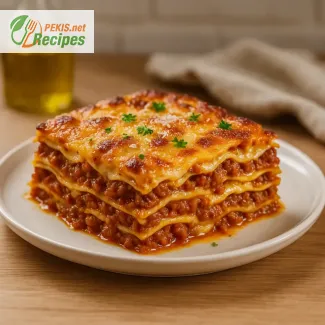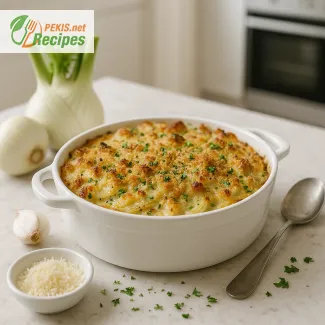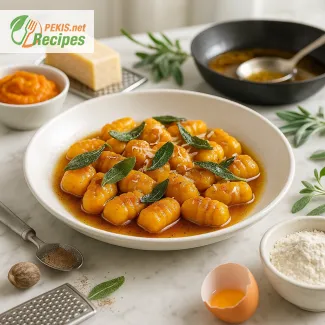
Traditional flavors reimagined: the soul of true Italian lasagna
Discover the story behind the ultimate homemade lasagna with layers of history, depth, and comfort
There are few dishes as universally beloved and emotionally evocative as authentic homemade lasagna. A symbol of Italian culinary heritage, this dish brings together slow-simmered meat sauces, silky béchamel, and tender pasta sheets in a harmonious layering that speaks of generations of tradition. Whether served at large family gatherings, special Sunday dinners, or cozy weeknight meals, lasagna is a dish that not only fills the plate, but also warms the heart.
An authentic lasagna recipe is more than just a combination of ingredients — it is a patient culinary process built on technique, balance, and carefully selected components. Unlike rushed versions that rely on shortcuts or over-processed sauces, this traditional recipe celebrates the slow build of flavor: the sweetness of sautéed onions, the depth of simmered tomatoes, the richness of ground beef and pork, and the velvety comfort of homemade béchamel.
Why authentic homemade lasagna is worth the time
One of the defining aspects of true Italian lasagna is the ragù alla Bolognese. While many modern adaptations favor a quick tomato-meat sauce, an authentic version is crafted through long, gentle cooking to coax out maximum flavor from a base of onions, carrots, celery, and meat. The sauce develops richness not only from time but also from the interplay between dry red wine, crushed tomatoes, and aromatic herbs like bay leaf and oregano.
Another signature layer in the Italian tradition is béchamel sauce, known in Italian as besciamella. Unlike the Americanized versions that rely on mozzarella-heavy fillings, the creamy béchamel adds a silky texture that balances the savory depth of the ragù. Its subtle creaminess elevates the lasagna to a level of refinement that makes it as appropriate for festive occasions as it is for simple comfort meals.
The art of layering: a delicate culinary architecture
Every layer in a traditional lasagna serves a purpose. The fresh lasagna sheets, whether store-bought or homemade, act as the structure that holds the flavors together. Their tender bite is crucial — al dente, never mushy, and ideally made with semolina flour and eggs for authenticity.
Each layer of ragù and béchamel must be spread evenly and precisely. The goal is to achieve balance — neither too dry nor too soupy, and always well-proportioned. Grated Parmigiano Reggiano is the final flourish between layers, lending a nutty complexity that deepens as the lasagna bakes. This cheese is essential for finishing, giving the top a golden crust while infusing the interior with aged flavor.
Craftsmanship in the kitchen: ingredients that make a difference
The key to perfect lasagna lies in ingredient selection. Choosing high-quality meats, fresh herbs, whole milk, and authentic Parmigiano Reggiano makes an immense difference. Tomatoes should be ripe and slightly sweet; canned San Marzano tomatoes are often the gold standard for their depth and low acidity. For the béchamel, real butter and whole milk ensure a smooth and luscious sauce that won’t separate or curdle.
Fresh pasta sheets, while not strictly required, dramatically enhance the final dish. Their soft texture absorbs the sauces beautifully and avoids the chewiness that can result from pre-cooked noodles. For those who opt to make pasta from scratch, using 00 flour and egg yolks will produce pasta with exceptional tenderness and flavor.
Cooking and resting: secrets to the perfect slice
After careful preparation and layering, baking the lasagna to perfection requires attention. A moderate oven temperature ensures even cooking without drying out the edges. The aromas of roasted tomato, caramelized cheese, and slow-cooked meat will fill the kitchen as the lasagna nears completion.
Crucially, once baked, lasagna must rest before slicing. This short resting period allows the layers to settle and firm up, ensuring clean portions and a satisfying structure. Serving it too early risks a sloppy consistency; allowing 15–20 minutes of rest rewards you with ideal texture and intensified flavor.
A dish rooted in heritage, elevated by precision
This authentic homemade lasagna recipe brings together the best of Northern Italian tradition with a refined approach to modern home cooking. Each component — from the ragù to the béchamel, the pasta to the cheese — is selected and prepared to highlight its individual characteristics while supporting the overall harmony of the dish.
Every bite tells a story of culinary craftsmanship: the hours of slow simmering, the thoughtful layering, the careful seasoning. It is a meal that represents celebration, comfort, and timeless quality, created not just to feed but to delight. Whether you’re preparing it for a special occasion or simply to enjoy the pleasures of a real Italian meal at home, this lasagna is a recipe that earns its place in every cook’s repertoire.
1. Prepare the meat ragù:
In a large saucepan, heat the olive oil over medium heat. Add the finely chopped onion, carrot, celery, and garlic. Sauté for 8–10 minutes until the vegetables are soft and fragrant. Add the ground beef and pork, and cook for 10 minutes, breaking up the meat until browned. Stir in the tomato paste and cook for 2 more minutes.
Pour in the red wine and let it simmer for 5 minutes to reduce. Add the crushed tomatoes, bay leaf, oregano, salt, and pepper. Lower the heat, cover partially, and let simmer gently for 45–60 minutes, stirring occasionally until thick and rich in flavor. Remove bay leaf before using.
2. Prepare the béchamel sauce:
In a separate saucepan, melt the butter over medium heat. Add the flour and whisk constantly for 2 minutes to form a roux. Slowly pour in the warm milk, whisking continuously to prevent lumps. Add nutmeg, salt, and white pepper. Cook for 8–10 minutes, stirring often, until the sauce thickens and coats the back of a spoon. Remove from heat.
3. Assemble the lasagna:
Preheat the oven to 180°C (350°F). In a baking dish (approx. 30 x 20 cm / 12 x 8 inches), spread a thin layer of meat ragù. Place a layer of fresh lasagna sheets on top, slightly overlapping. Spread a layer of béchamel sauce, then more ragù, and sprinkle with grated Parmigiano Reggiano. Repeat the layering process (pasta – béchamel – ragù – cheese) until all ingredients are used, finishing with a layer of béchamel and Parmigiano on top.
4. Bake the lasagna:
Cover with aluminum foil and bake for 30 minutes. Remove the foil and bake an additional 15–20 minutes until the top is golden and bubbling. Let the lasagna rest for at least 15–20 minutes before slicing and serving. This helps the layers settle and enhances the flavor.
Elevate Your Lasagna: Smart Twists on the Classic Italian Recipe
How to enhance flavor, texture, and nutrition in homemade lasagna
The appeal of authentic homemade lasagna lies in its comforting richness and layered complexity. But even this timeless Italian dish can be improved with thoughtful adjustments, higher-quality ingredients, and mindful techniques. Whether you're aiming for deeper flavor, a healthier profile, or just a more refined finish, small changes can yield big results. From creative ingredient swaps to common cooking pitfalls to avoid, mastering lasagna is as much about experience as it is about tradition.
Use higher-quality meat or add sausage for richer depth
The combination of ground beef and pork is traditional, but you can take your meat ragù to the next level by using freshly ground meat or incorporating a portion of Italian sausage. Sausage brings a spicy, herbaceous note that intensifies the overall flavor. Choosing meat with a slightly higher fat content (such as 80/20 beef) ensures the sauce stays moist and flavorful after long cooking. Avoid overly lean blends, which can result in a dry or crumbly texture.
Fresh pasta sheets make all the difference
While store-bought lasagna sheets are convenient, fresh pasta offers a tender, luxurious bite that elevates the entire dish. Making your own pasta with 00 flour and egg yolks delivers superior results — the sheets absorb sauce better and don’t turn mushy during baking. If you use dried pasta, parboil it for a few minutes before layering to avoid undercooked or overly firm layers.
Enhance béchamel with infused flavor
A traditional béchamel sauce is neutral and creamy, but you can subtly improve it by infusing the milk with bay leaf, clove, or onion before adding it to the roux. This adds gentle aromatic undertones and depth without overpowering the other components. Be cautious not to add too much nutmeg — a small amount enhances the sauce, while too much can create a jarring flavor contrast.
Balance acidity in the ragù
Tomatoes provide brightness and richness, but depending on the variety used, they can introduce too much acidity. To counteract this, add a small pinch of sugar or a splash of milk toward the end of cooking. These ingredients round out the sharpness and enhance the sweetness of the tomato without masking the savory profile of the ragù.
Layering technique impacts final texture
One of the most frequent mistakes in homemade lasagna is overloading the layers. While it’s tempting to be generous with sauce and cheese, thick or uneven layers can lead to an unbalanced and soggy result. Use thin, even spreads of béchamel and ragù to maintain structure and ensure a clean slice. Always finish with béchamel and a generous dusting of Parmigiano Reggiano for a golden, crispy crust.
Upgrade cheese selection for added complexity
While Parmigiano Reggiano is a staple in traditional lasagna, you can introduce aged Pecorino Romano for a sharper, saltier kick. Avoid pre-grated cheeses that often contain anti-caking agents and don’t melt as smoothly. Always grate cheese fresh for better melting and more intense flavor.
Homemade lasagna is more than the sum of its parts
Preparing lasagna from scratch allows for complete control over every element, from seasoning to texture. It avoids preservatives and excessive sodium often found in pre-packaged versions. More importantly, cooking at home creates a more harmonious flavor profile, where each layer supports the next without overpowering it. A homemade version also gives you the freedom to adjust based on dietary needs or ingredient preferences.
Common mistakes to avoid
- Undercooking the ragù: Rushing the sauce leads to underdeveloped flavor and watery consistency. Let it simmer at least 45 minutes.
- Skipping resting time: Slicing lasagna straight from the oven results in sloppy portions. Let it rest 15–20 minutes before serving.
- Using low-quality canned tomatoes: These can be overly acidic or bland. Opt for San Marzano or high-quality whole peeled tomatoes for best results.
- Overbaking or baking uncovered: Dry, cracked tops and uneven cooking happen without foil. Bake covered, then finish uncovered for a golden crust.
Healthier adaptations without sacrificing flavor
You can lighten the dish while retaining its essence with strategic substitutions:
- Use turkey or chicken mince instead of beef and pork for a leaner ragù.
- Swap whole milk in béchamel with unsweetened oat or almond milk to reduce saturated fat.
- Replace part of the béchamel with a pureed cauliflower sauce for lower calorie density and extra fiber.
- Include finely chopped spinach or zucchini in the sauce for added nutrients and moisture.
Add vegetables for texture and balance
To introduce more variety and reduce heaviness, add grilled eggplant slices, sautéed mushrooms, or roasted bell peppers between layers. These additions contribute umami and complement the richness of the meat and cheese. Be sure to drain or roast vegetables thoroughly before layering to avoid excess moisture.
Experiment with herbs and aromatics
For a more vibrant profile, consider adding fresh basil, thyme, or a touch of chili flakes to the ragù. These ingredients boost aroma and add complexity. However, avoid overpowering the dish — balance is essential to maintain its traditional character.
Better taste through patience
Lasagna made a day ahead and refrigerated often tastes even better after reheating. The resting time allows the flavors to meld and deepen. Reheat gently in the oven, covered with foil, to maintain moisture and texture.
These thoughtful variations and improvements can help you personalize the classic lasagna recipe while maintaining its traditional soul. By applying these tips, you elevate a beloved favorite into a dish of true culinary craftsmanship, full of flavor, balance, and comfort.
Allergens present in the recipe:
- Gluten: in lasagna sheets and flour
- Dairy: in milk, butter, Parmigiano Reggiano
- Eggs: may be present in fresh pasta (check packaging)
Substitution tips to reduce allergens:
- Gluten-free version: Use gluten-free lasagna sheets and cornstarch instead of flour for béchamel.
- Dairy-free version: Replace butter with plant-based margarine, milk with unsweetened soy or oat milk, and cheese with a dairy-free alternative.
- Egg-free pasta: Choose egg-free lasagna sheets, typically labeled as vegan.
Vitamins and minerals per serving (approximate):
- Vitamin A: 1800 IU – supports eye and skin health
- Vitamin B12: 1.5 µg – important for red blood cell production
- Vitamin D: 1.2 µg – aids calcium absorption and immune function
- Calcium: 260 mg – essential for bone strength
- Iron: 3.8 mg – supports oxygen transport in the blood
- Magnesium: 45 mg – helps muscle and nerve function
- Zinc: 4.5 mg – boosts immune response and healing
Antioxidants per serving (approximate):
- Lycopene: 6.5 mg – found in tomatoes; protects cells from oxidative damage
- Beta-carotene: 1.2 mg – from carrots; supports immune health and skin elasticity
- Selenium: 18 µg – helps combat inflammation and supports thyroid function





